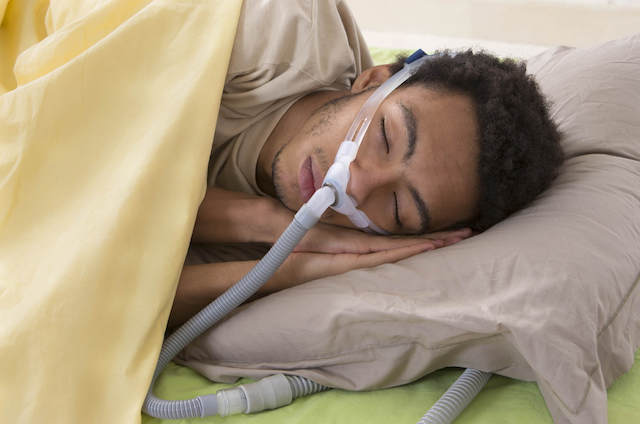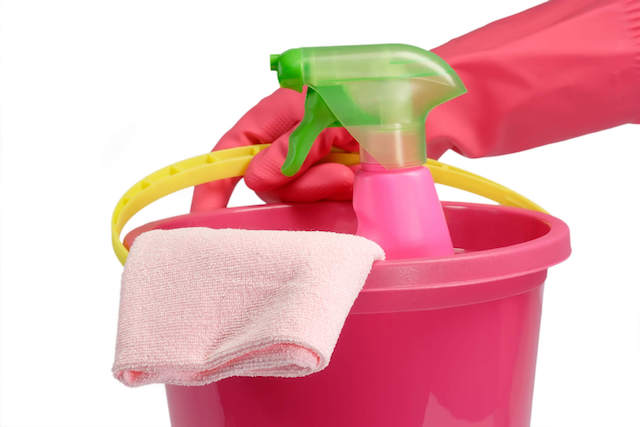Breathe In. Breathe out. Repeat. While typically this process is an unconscious action regulated by our autonomic nervous system, the activity doesn’t always work how it’s supposed to which can lead to issues such as sleep apnea. In a nutshell, issues get in the way of breathing properly while sleeping, like crossed signals in the brain or throat muscles relaxing, causing the body to not receive the amount of oxygen it needs to function properly. Thankfully, there are options such as the CPAP machine to help regulate breathing while asleep.¹ Without proper care, though, mold in a CPAP machine can turn these breathing apparatus into health hazards.

Getting enough sleep is crucial for helping ensure that the body and mind are functioning properly.² Without it, issues such as mood swings, high blood pressure, and immune system dysfunction can occur. CPAP machines can be an invaluable tool in helping individuals with sleep apnea get the restful sleep their bodies need, but the benefits trickle off when mold joins the picture. Once this fungus among us settles into the machine, it’s not just oxygen being provided to the body while sleeping, moldy particles are catching a ride as well.
Unfortunately, this situation happens in the blink of an eye and wreaks havoc on the health of those using these machines. Understanding why this occurs and how to prevent mold in a CPAP machine can help ensure that sleep is uninterrupted by problems such as breathing in contaminated air.
Here’s everything you need to know.
What is a CPAP Machine?
As mentioned above, some individuals struggle to get proper rest because their bodies' normal inhalation processes malfunction, causing breathing to pause for seconds or minutes while sleeping.³ For some, this occurs hundreds of times throughout the night, resulting not only in inadequate sleep but also a lack of oxygen to the brain.
To help regulate the breathing of those suffering from sleep apnea, researchers developed tools such as the CPAP machine.⁴’⁵ Short for continuous positive airway pressure, a CPAP machine delivers continuous pressurized air into a mask that is worn while sleeping. By keeping the airways open, those suffering from sleep apnea won’t stop breathing, allowing their bodies to receive the oxygen they need.
Like any technological innovation, these tools can be incredibly beneficial, or they can be harmful if improperly maintained. Those in need of a little help while sleeping must stay on top of proper care to ensure that mold in a CPAP machine doesn’t throw a wrench in their breathing assistance.
Why Does Mold in a CPAP Machine Happen?
Knowing how to keep these machines in tip-top shape included understanding why mold loves them oh so much. This involves knowing the 411 about this fungus among us.
What’s Mold’s Deal?
Researchers have discovered over 100,000 species of mold so far around the world. Each species reproduces by creating microscopic spores that they release into the air.⁶’⁷ These spores will travel to wherever the wind takes them and stick to whatever surface they brush us against. Like seeds produced by plants, these spores will remain non-living particles until they find an environment with the right components they need to live.
Thanks to the hardy nature of spores, they only need four simple things to transition into the world of the living.⁸

These four components are:
- Oxygen: This barely counts, which is why mold can grow inside walls.
- Temperature: Most prefer 40-90℉, but some species can live in extremes.
- Food: They eat most things, like dust and organic matter.
- Moisture: The often missing element.
If a spore lands on a surface with these four elements for 24-48 hours, it will start to grow, put down roots called hyphae, and begin releasing spores into the surrounding environment.
Understanding this process is important because it helps clear up the confusion and misinformation surrounding this fungus. Oftentimes, the comment, “Well, mold is everywhere so it’s no big deal if it’s in a home. It’s just unavoidable,” comes up when discussing indoor mold growth. Yes, mold particles can be found in most environments, and thanks to their small size, they can fly right through the front door into a home. That doesn’t mean that mold growth in a home isn’t a problem, though.
Sure, we encounter a few mold particles throughout the day while walking into work or driving in the car, but that’s nowhere near the same situation as encountering a home with an active colony such as mold in a CPAP machine. Instead of just a couple of particles here and there throughout the day, the body is now facing a whole army of them every time the individual is in the home and using the machine. Considering that the average individual is recommended to sleep 7-9 hours a night, that’s a lot of face and lung time with this indoor contaminant.⁹
Some species of mold can also produce a toxic byproduct called mycotoxins, creating even more particles for the body to deal with.¹⁰ This level of exposure is much greater and can cause a long list of adverse health reactions.
How Does Mold In A CPAP Machine Occur?
As mentioned above, spores really only need moisture and food to transition into a living colony which makes mold in a CPAP machine fairly easy to accomplish if preventative measures are not taken.

When it comes to a food source, edible options are in abundance thanks to skin cells introduced while it’s in use and dust and other organic matter being drawn in by the filter. All of these can provide a hardy little mold spore with the sustenance it needs to thrive and survive.
As for moisture, this can be introduced in a variety of ways. For machines with a built-in humidifier to help the airway not get too dry, this supplies a readily available source of water. Breathing into the machine itself provides moisture through water vapor released with each inhalation as well.¹¹ Indoor humidity can also allow for growth as the moist air is pulled into the machine.
Again, provided these components for 24-48 hours and mold in a CPAP machine can pop up and start causing problems.
Mold in a CPAP Machine: The Health Effect
With mold spores and related particles being so small, they’re able to enter the body either through inhalation, absorption, or ingestion. The EPA qualifies these types of particles into two categories, both of which can make their way into the body.¹²
These two categories are:
- PM10: particles that have a diameter of around 10 micrometers or less.
- PM2.5: fine particles that have a diameter of around 2.5 micrometers or less.
As they enter the body, the immune system will descend and get rid of them, which is why exposure to a few particles throughout the day typically isn’t a big deal. However, as exposure to something like mold in a CPAP machine goes on, those particles continually enter the body and can cause the immune system to get bogged down and malfunction. As toxicity builds up, a long list of adverse health reactions and related autoimmune conditions can develop.

Symptoms of mold exposure can include:
- Coughing
- Rashes
- Digestive issues
- Brain fog
- Hair loss
- Respiratory problems
- Chronic fatigue
- Runny nose
- Mood swings
- Neurological issues
The truth is, though, that no two individuals respond to mold exposure the same way.¹³’¹⁴’¹⁵’¹⁶’¹⁷ Researchers are still attempting to determine exactly how this indoor contaminant impacts health, but it’s a tricky subject to nail down. Factors such as genetics, species of mold, the presence of mycotoxins, immune systems status, and length of exposure all play a role.
What they do know is that individuals with compromised or developing immune systems are at greater risk of experiencing symptoms faster and to a greater extent.
Regardless, the potential for any type of adverse health reaction is reason enough to take steps to actively prevent mold in CPAP machines from occurring and have an action plan in place should it pop up.
How to Tell If There’s Mold in a CPAP Machine
Determining if a problem exists involves relying on sight, smell, and feel.
The Visual Factor
With so many species existing in the world, mold colonies can come in a variety of colors, shapes, and textures. Some of the most common colors include green, white, grey, blue, red, black, brown, or a combination of them. As for textures, they could be fuzzy, powdery, velvety, or slimy.
If any type of unidentifiable growth pops up on the machine, it's a safe bet to go ahead and assume there’s a mold problem.
The Smell Factor
Mold growth isn’t always visible. It could be in a hidden area in the machine or the colony is too small to be visible to the naked eye yet. In this instance, look to your nose to help determine if there’s a problem.
Growing mold often creates an earthy, musty, damp smell due to releasing gases called microbial volatile organic compounds (MVOC).¹⁸ If this odor is coming from the machine, it points to a problem existing inside.
The Health Factor
To make matters even more difficult, not all mold growth is visible, and not all mold growth emits an odor. In cases such as this, it’s important to pay attention to how you feel when around the machine or after using it. If chronic symptoms seem to spark up or become worse over time every time, particularly after being around the device, and no doctor can pinpoint a problem, exposure to mold in the CPAP machine might be the root cause.
Our bodies are incredible warning systems that will alert us if something’s wrong, including if there’s a contaminant in our indoor environments. It’s up to us to listen to these signals and figure out what the root cause is so that it can be eliminated.
If any of these occur, it’s time to get started on getting rid of mold in a CPAP machine.
How to Get Rid of Mold in a CPAP Machine
The unfortunate truth is that once mold in a CPAP machine occurs, the best way to handle the situation is to get rid of the machine altogether. As its main purpose is to send air straight into the lungs to regulate breathing, having any contamination inside is not a great way to promote health and wellbeing.
Completely getting rid of these particles is also a problem. Mold can oftentimes grow in hard-to-reach areas and other contaminants like mycotoxins and bacteria are particularly difficult to remove. If all of these aren’t eliminated, exposure to mold in a CPAP machine will continue. As the EPA says, even dead mold can trigger symptoms, which is why bleach should never be a go-to tool to get rid of mold.¹⁹

Those dealing with mold in a CPAP machine can attempt to remediate it, but it’s best just to toss it in a trash can outside and start fresh. If you do decide to attempt to remediate your CPAP machine, follow the steps below to thoroughly clean it out. Make sure to complete the process at least three times to eliminate hard-to-remove particles like mycotoxins.
Tools Required
- Protective gear: Gloves, a mask, and goggles will help protect you from particles directly on the machine and any kicked up into the air while cleaning
- HEPA vacuum: To qualify as HEPA, the machine must remove at least 99.7% of particles up to 0.3 microns in size.²⁰
- Microfiber towels: Microfiber towels are 100 times better than regular rags at wiping away small particles.
- White vinegar: Vinegar is a descaler, meaning that pulls particles from a surface, and it’s antibacterial and antifungal, which helps prevent mold and bacterial growth. Simply killing the mold is never the complete answer because some particles remain on the surfaces and will continue to cycle through the machine when it’s in use. You need something to discourage mold growth, eliminate particles from the surface, and actively remove mineral buildup. Spores can use mineral buildup as a food source, so it all has to go.
Before getting started, check out the manufacturer’s instructions for their recommended cleaning steps, what can be removed to clean, and which products they suggest. Every machine is different, so it’s important to follow the brand’s guidelines. After taking a look, you can jump in and get started.
Deep Cleaning Steps Include:
- Put on the protective gear.
- Turn the machine off and unplug it.
- Disconnect the tubing, mask, headgear, and humidifier tank (if applicable) and soak in white vinegar for half an hour. Double-check the manufacturer's instructions for the headgear, though, as some do not suggest using vinegar and can only be washed with a mild soap.
- After soaking, thoroughly wipe down each piece with a microfiber towel. For hard-to-reach areas like the tube, use a small brush.
- Wash each piece with a mild soap, rinse with water, wipe again with a fresh microfiber towel, and then leave out to dry completely.
- Use the HEPA vacuum on the machine itself to thoroughly remove as many particles as possible and then wipe with a microfiber cloth. Typically, manufacturers suggest steering clear of any product on the machine itself but check the instructions just to make sure.
- Remove and replace the filter with a new one. For reusable filters, check the manufacturer’s instructions on proper cleaning protocols. Typically, you can HEPA vacuum it and then soak it in white vinegar for half an hour, gently wipe it with a microfiber towel, wash it again with a mild soap, rinse, and dry completely.
- Allow everything to dry completely before putting it all back together.
If this process is being attempted in an effort to get rid of mold in a CPAP machine, keep a close eye on it afterward. If the mold comes right back or symptoms persist or develop, immediately stop using it and get a new one.
How to Prevent Mold in a CPAP Machine
As this machine touches your face every night, it’s best to keep it as clean and free from contamination as possible. Not only will it help prevent mold growth, but also bacteria as well.
Steps to prevent mold growth in a CPAP machine include:
- Daily maintenance: Empty out the water reservoir, wash it with a mild soap, wipe it with a microfiber towel, and leave it out to dry. Disassemble the mask, clean each part with a mild soap, wipe with a microfiber towel, and leave everything out to dry completely.
- Deep clean weekly: Using the steps above, deep clean the machine, making sure to leave everything out to dry before putting it back together again.
- Replace the filter on time: Follow the manufacturer’s instructions and replace the filters on time to ensure build-up doesn't occur and the machine operates properly.

- Use distilled water: This type of water will help prevent mineral buildup in the machine that mold can use as a food source.
- Replace each part on time: Set a reminder to replace all removable parts per the manufacturer's instructions. Typically, mask and tubing replacement are at three months, headgear and water chamber are at six months, and the mask cushion is every month.
- Maintain low indoor humidity: Ensure that the humidity inside stays within 30-50% to discourage mold growth.²¹
Adding the steps above can help ensure that your CPAP machine stays clean and safe to use. Keep in mind that these tools also have a recommended life expectancy of five years before needing to be replaced. The older they get, the more wear and tear they have which can lead to mold in a CPAP machine.
Breathing Clean Air
As a society, we don’t always consider the quality of the air we’re breathing in, the state of our indoor environments, and how they can affect our health. When the average individual breathes around 20,000 breaths a day, these must be factored in to help promote health and wellbeing.²²
Ensuring that mold in a CPAP machine doesn’t occur is an excellent step toward promoting health, especially since it supplies air directly to the body. Plus, no one wants to breathe in moldy air while they’re sleeping. And, when in doubt, contact an expert to discuss any questions of concerns you have.
Health begins at home.™

Citations:
- Guyenet P. G. (2014). Regulation of breathing and autonomic outflows by chemoreceptors. Comprehensive Physiology, 4(4), 1511–1562. https://doi.org/10.1002/cphy.c140004
- Team, B. and S. (2022, March 25). Here's what happens when you don't get enough sleep (and how much you really need a night). Cleveland Clinic. Retrieved from https://health.clevelandclinic.org/happens-body-dont-get-enough-sleep/#:~:text=Some%20of%20the%20most%20serious,function%20and%20lower%20sex%20drive.
- Mayo Foundation for Medical Education and Research. (2020, July 28). Sleep apnea. Mayo Clinic. Retrieved from https://www.mayoclinic.org/diseases-conditions/sleep-apnea/symptoms-causes/syc-20377631.
- Cleveland Clinic. (2021, November 9). CPAP machine: What it is, how it works, pros & cons. Cleveland Clinic. Retrieved from https://my.clevelandclinic.org/health/treatments/22043-cpap-machine#risks--benefits.
- Zieliński J, Przybylski J. Ile wody tracimy z oddechem? [How much water is lost during breathing?]. Pneumonol Alergol Pol. 2012;80(4):339-42. Polish. PMID: 22714078.
- Centers for Disease Control and Prevention. (2017, March 2). CDC - how much sleep do I need? - sleep and sleep disorders. Centers for Disease Control and Prevention. Retrieved April 12, 2022, from https://www.cdc.gov/sleep/about_sleep/how_much_sleep.html.
- Environmental Protection Agency. (n.d.). Mold. EPA. Retrieved from https://www.epa.gov/mold.
- Centers for Disease Control and Prevention. Basic facts about mold and dampness. Centers for Disease Control and Prevention. Retrieved from https://www.cdc.gov/mold/faqs.htm.
- Lstiburek, J., Brennan, T., & Yost, N. (2002, January 15). Rr-0208: What you need to know about mold. Building Science Corporation. Retrieved from, https://www.buildingscience.com/documents/reports/rr-0208-what-you-need-to-know-about-mold/view.
- World Health Organization. (n.d.). Mycotoxins. World Health Organization. Retrieved from https://www.who.int/news-room/fact-sheets/detail/mycotoxins.
- EPA. (n.d.). Health and Environmental Effects of Particulate Matter (PM). EPA. Retrieved from https://www.epa.gov/pm-pollution/health-and-environmental-effects-particulate-matter-pm.
- Environmental and Occupational Health Assessment Program, & Environmental and Occupational Health Assessment Program, & Health Science Section, Mold Basics for Primary Care Clinicians (2009). Hartford, CT; Connecticut Department of Public Health. , H. S. S., Mold Basics for Primary Care Clinicians 1–10 (2009). Hartford, CT; Connecticut Department of Public Health.
- Curtis, L., Lieberman, A., Stark, M., Rea, W., & Vetter, M. (2004). Adverse health effects of indoor molds. Journal of Nutritional & Environmental Medicine, 14(3), 261-274.
- Bush, R. K., Portnoy, J. M., Saxon, A., Terr, A. I., & Wood, R. A. (2006). The medical effects of mold exposure. Journal of Allergy and Clinical Immunology, 117(2), 326-333
- Fisk, W. J., Lei-Gomez, Q., & Mendell, M. J. (2007). Meta-analyses of the associations of respiratory health effects with dampness and mold in homes. Indoor air, 17(4), 284-296.
- Wild, C. P., & Gong, Y. Y. (2010). Mycotoxins and human disease: a largely ignored global health issue. Carcinogenesis, 31(1), 71-82.
- Environmental Protection Agency. (n.d.). What does mold smell like? EPA. Retrieved from https://www.epa.gov/mold/what-does-mold-smell
- EPA. (n.d.). Should I use bleach to clean up mold? EPA. Retrieved from https://www.epa.gov/mold/should-i-use-bleach-clean-mold.
- EPA. (n.d.). What is a HEPA filter? EPA. Retrieved November 16, 2021, from https://www.epa.gov/indoor-air-quality-iaq/what-hepa-filter-1.
- EPA. (n.d.). A Brief Guide to Mold, Moisture, and Your Home. EPA. Retrieved from https://www.epa.gov/mold/brief-guide-mold-moisture-and-your-home#tab-6.
- Brown, A. (2014, April 28). How Many Breaths Do You Take Each Day? [web log]. Retrieved from How Many Breaths Do You Take Each Day?

